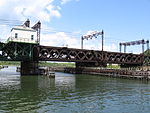Statue of Christopher Columbus (Norwalk, Connecticut)
Buildings and structures in Norwalk, ConnecticutConnecticut stubsMonuments and memorials in ConnecticutMonuments and memorials removed during the George Floyd protestsOutdoor sculptures in Connecticut ... and 5 more
Sculptures of men in ConnecticutStatues in ConnecticutStatues of Christopher ColumbusStatues removed in 2020United States sculpture stubs
A statue of Christopher Columbus was installed in Norwalk, Connecticut, United States.
Excerpt from the Wikipedia article Statue of Christopher Columbus (Norwalk, Connecticut) (License: CC BY-SA 3.0, Authors).Statue of Christopher Columbus (Norwalk, Connecticut)
West Avenue, Norwalk
Geographical coordinates (GPS) Address Nearby Places Show on map
Geographical coordinates (GPS)
| Latitude | Longitude |
|---|---|
| N 41.109606 ° | E -73.418521 ° |
Address
West Avenue 242
06850 Norwalk
Connecticut, United States
Open on Google Maps






